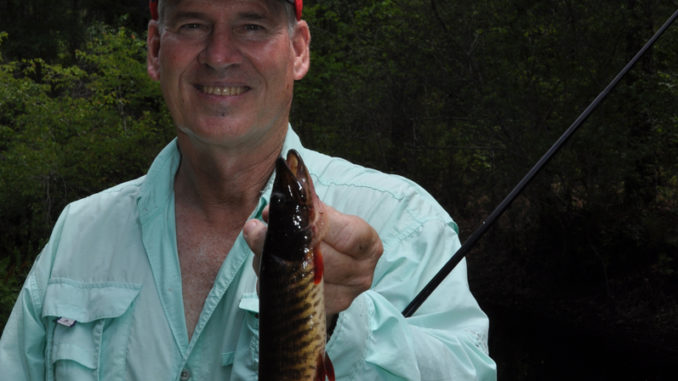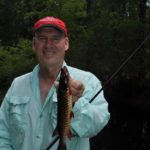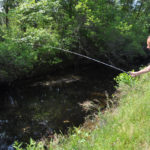
Don’t dismiss the ditch pike when warm weather comes to the blackwater, coastal streams of southeastern North Carolina
The Lumber River forms the boundary between Robeson and Columbus counties and cuts across the North Carolina-South Carolina border. While geographically important, the true value of the river is that it is the lifeblood of local anglers because its floodplain creates habitats that support many fish species.
Many unusual fish inhabit the river’s backwater creeks. Stained black as burnt coffee with tannin from the soil and decaying vegetation, the water is nothing like the crystal-clear waters of a trout stream. However, one of its native fish is as beautiful as any rainbow trout. Unlike mountain trout, however, there is no size or creel limit on the redfin pickerel.
Ray Atkinson, 75, from Fairmont, fishes for redfin pickerel with as much passion as any mountain angler targets trout. He was standing beside a canal on Fair Bluff Road that is part-and-parcel to the river’s swamp ecosystem when he felt a nibble. He responded by jerking back and hauling a bowfin from the water. The bowfin, aka blackfish, is an ancient fish with independently directed tubular nostrils and razor-sharp teeth, adaptations that help them survive when oxygen levels are low. However, it was not a fish Atkinson wanted to catch.
“A bowfin bit a hole in my landing net and swam right through it,” said Atkinson, who is retired. “I sure don’t like catching them when I’m pikin’.”
“Pikin’” is a term most anglers under the age of 40, or any hailing from outside the coastal plain’s deepest, darkest swamps, will not recognize. Atkinson remembers from his youth that parked vehicles on the side of the road for miles.
“There were so many cars here back then that it looked someone was having a funeral,” he said. “Now look. I am the only one out here fishing today.”
The few remaining practitioners of pikin’ like it because they are addicted to catching the smallest of North Carolina’s two species of pickerel. The largest is the chain pickerel, esox niger, aka jackfish, which grows much larger and is identified by its chain-like markings. While a chain pickerel can weigh more than 3 pounds, a redfin pickerel, esox americanus, aka ditch pike, redfin pike or grass pickerel, seldom weighs a pound. While small, they are stunningly beautiful fish, with scarlet fins, tarnished copper flanks with dark stripes and dark slashes across their eyes.
Anglers who target mountain trout appreciate small fish of a similar streamlined shape for the same reasons Atkinson enjoys catching redfin pickerel. His plastic pail was teeming with pickerel, many of them already fins-up, showing off such striking color they could make a trout blush with envy. As with mountain trout, another attribute of ditch pickerel besides the fun of catching them is eating them.
“A redfin pike is the best-eating fish in freshwater,” he said. “You can’t believe how good one tastes until you’ve tried it.”
Like chain pickerel, redfin pickerel have Y-bones in their skeleton. But there’s no need for extreme means of cleaning and filleting redfins.
“I just scale, head and gut redfin pike like any panfish,” he said. “Then I fry them. Once they are cool enough, I hold them upside down in the palm of one hand and reach down through the rib cage with the other to pull out the backbone. All the other bones come right out with the backbone, so all you have left is great tasting fish to eat.”
For catching redfins, Atkinson uses a 12-foot telescoping fiberglass pole, the modern version of the cane poles he probed for pickerel with when he was a kid. While his equipment has modernized, his method has not.
“I tie on some 12-pound line and a hook or small jig,” he said. “I use a pike fin for bait after catching the first one on a piece of fatback.”
Removing a pike from the pail, he used scissors to snip a two-inch strip from its flank surrounding the scarlet pelvic fin. Hooking it, he flipped it into the water and wiggled it along the edge of a bed of alligator weed. Moments later, the rod tip twitched. He jerked hard and snatched a redfin high into the air and rotating the rod away from the water.
“The instant a pike strikes, you have to jerk it out of the water and get it over the bank,” he said. “If it falls off the hook onto the slope, it flips back down the bank, and it’s gone.”
Atkinson carefully opened the fish’s mouth to reveal its sharp teeth. A redfin pickerel can chomp down on prey or a bait with such a powerful grip that it does not swallow it immediately. About half the time when an angler hauls a redfin from the water, it opens its mouth so fast the hook falls free and the fish drops away. Jerking hard doesn’t help the hookset, but it gets the fish up on the bank immediately.
Atkinson also uses a small, one-man boat to slip along the swamp runs and catch redfins.
“I drop my hook beside any piece of cover,” he said. “If I see a pile of limbs and floating leaves, I look for an opening in the leaves, because a fish might be underneath them, moving its fins or feeding and clearing out that little hole.”
Atkinson said 100-fish days are not uncommon; that’s enough fish to fill a 5-gallon bucket. But he usually fishes only the morning hours before calling it quits to avoid the sun’s rays. A typical day is 40 fish.
Joe Rochelle, a retired roofer from Maple Hill, is another angler who enjoys catching redfin pickerel. He fishes the Sandy Run Swamp in Pender and Onslow counties.
“I began pikin’ when I was four or five years old,” he said. “I am disabled due to back problems, but I can still fish from the bank.”
Rochelle said most of the creeks where he catches redfin pickerel run through private property. Anglers can park and climb down the banks to fish beneath highway bridges. However, before leaving any state road right-of-way, they need permission to enter private property, the same as with mountain trout fishing.
“Most of the time they are in extremely acid headwater creeks,” he said. “I fish about 10 miles upstream of Maple Hill. We walk the banks and find the most fish in the places that will dry up if it does not rain. I don’t know how they survive when the water is low. You might catch only a few one year in a good spot. Then, the next year, they are abundant again.
Rochelle used a pickerel tail for bait when fishing with a cane pole when he was a child. He has since modernized his tactics.Just like trout fishermen in mountain streams, he often sees fish before he starts fishing. Pickerel look like waterlogged leaves just beneath the surface, so it takes some experience to spot them. If the water is clear, seeing them is easier.
“To use a tail for bait, first you have to catch a pike,” he said. “They will hit just about anything, and I have used the wrapper from a piece of baloney to make jigs for catching them. I just cut short pieces of the red ribbon and tied them on a hook. A pike will hit anything moving, including worms and crickets.”
These days, rather than a pole, Rochelle uses a spincast rig with 6-pound monofilament. Instead of bait, he fishes with lures. While a pickerel may let go of a live or cut bait fished on a pole and fall back into the water, the hook is set solidly when the fish strikes a fast-moving lure.
“My favorite is a Rooster Tail,” he said. “The best colors are white or red, and the size doesn’t matter. The important thing is to start reeling in right when the lure hits the water. Otherwise, it will sink and snag on any twig, root or cypress knee. You don’t want to break off the lure or leave a lot of line in the creek to tangle with the next time you go fishing.”
DESTINATION INFORMATION
HOW TO GET THERE — From Charlotte or Wilmington, take U.S. 76 to Fair Bluff. A public boat ramp is located east of the intersection of US 76 and NC 904. Launch and head north into the Lumber River lowlands. Pickerel are also in the ditches along Fair Bluff Road off NC 904.
WHEN TO GO — The best bite begins in May and can continue through the summer, depending upon water level. As long as the rivers stay in their banks, redfin action is good.
BEST TECHNIQUES — To catch the first redfin pickerel,
Light tackle is the ticket, with spinning or spincast reels loaded with 6-pound monofilament. Small, in-line spinners such as Rooster Tails or Road Runners in red and white are the most productive lures. A piece of fatback or bacon fished on a small hook or jig tied to the line of a 12-foot telescoping pole will work. The tail and pelvic fins of pickerel can be used as bait.
FISHING INFO/GUIDES — K.C. Bullard, Ricky Ward, Lumber River Outdoors, 910-863-1220, www.lumberriveroutdoors.com See also Guides and Charters in Classifieds.
ACCOMMODATIONS — While overnight accommodations are scarce, overnight guided trips with lodging are available from Lumber River Outdoors, 910-863-1220, www.lumberriveroutdoors.com.
MAPS — DeLorme’s North Carolina Atlas and Gazetteer, 800-452-5931 or www.delorme.com.






Be the first to comment